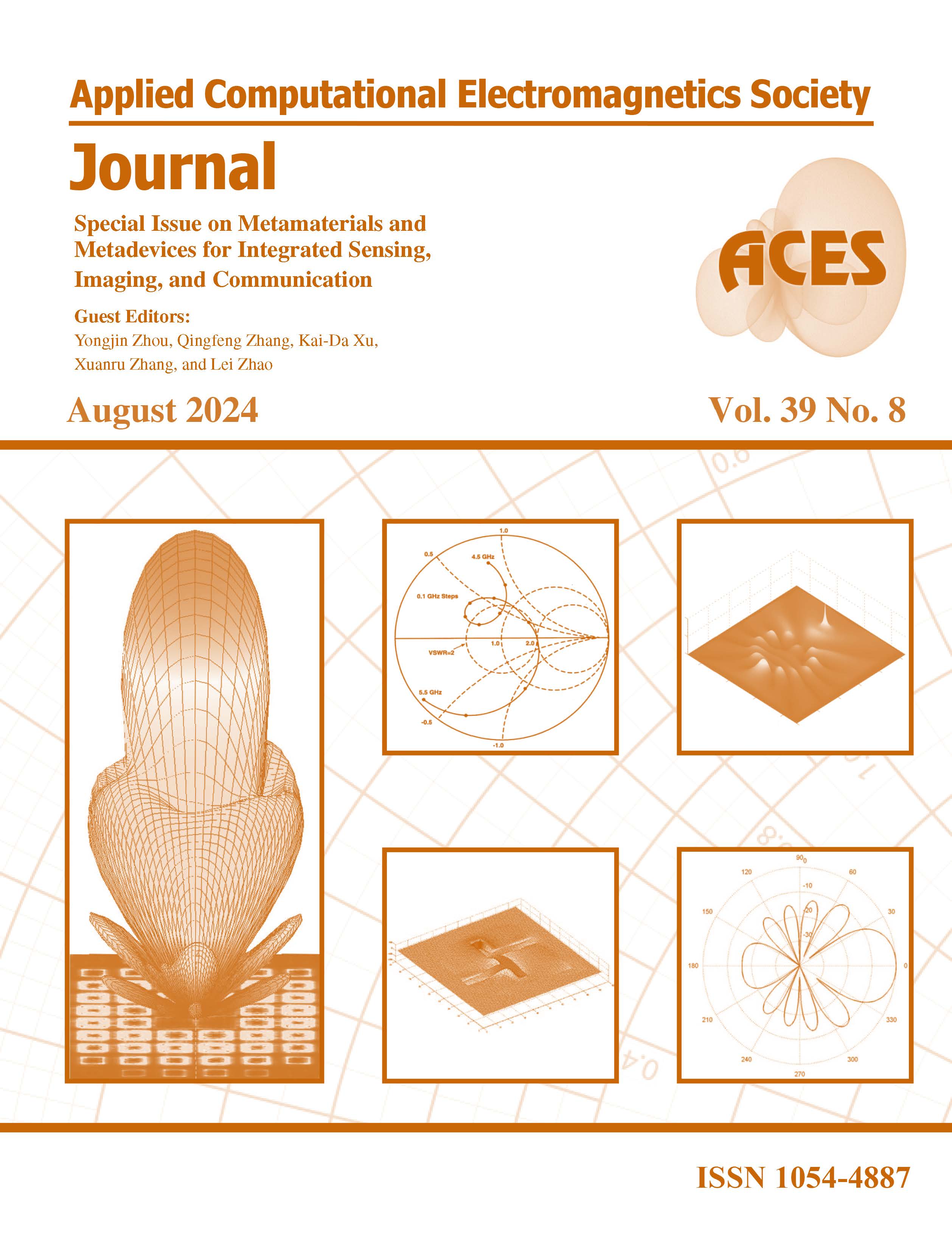QPSK-modulation Wireless Transmitter Based on Time-domain Coding Metasurface
DOI:
https://doi.org/10.13052/2024.ACES.J.390805Keywords:
Metasurfaces, time-domain digital coding, wireless communicationAbstract
In this paper, a wireless communication system based on time-domain digital coding metasurface with Quadrature Phase Shift Keying (QPSK) modulation is proposed. The aperture-coupled resonant rings on the metal patches of the metasurface elements create an asymmetry along the x-axis, resulting in a phase difference. The Field Programmable Gate Array (FPGA) is used to change the conduction and cutoff states of pin diodes, which can control the phase responses of the metasurface elements, forming four coding states. Within a certain period, the FPGA dynamically modulates the high and low levels, thus controlling the reflection characteristics of the metasurface. When the information is converted into a binary bitstream and written into the FPGA, represented by high and low levels, the baseband signal is modulated onto the carrier by the metasurface. This system replaces the functionality of mixers in traditional wireless communication systems, further simplifying the architecture of wireless communication systems. The overall system is demonstrated by an experiment with a picture transmitted and received in real time, showing promise in future low-cost wireless communication transmission systems.
Downloads
References
T. Wild, V. Braun, and H. Viswanathan, “Joint design of communication and sensing for beyond 5G and 6G systems,” IEEE Access, vol. 9, pp. 30845-30857, Feb. 2021.
E. De Carvalho, A. Ali, A. Amiri, M. Angjelichinoski, and R. W. Heath Jr., “Non-stationarities in extra-large-scale massive MIMO,” IEEE Wireless Communications, vol. 27, no. 4, pp. 74-80, Aug. 2020.
V. Jamali, A. M. Tulino, G. Fischer, R. Muller, and R. Schober, “Intelligent surface-aided transmitter architectures for millimeter-wave ultra-massive MIMO systems,” IEEE Open Journal of the Communications Society, vol. 2, pp. 144-167, Dec. 2020.
S. Hu, F. Rusek, and O. Edfors, “Beyond massive MIMO: The potential of data transmission with large intelligent surfaces,” IEEE Transactions on Signal Processing, vol. 66, no. 10, pp. 2746-2758, May 2018.
M. Alibakhshikenari, E. M. Ali, M. Soruri, M. Dalarsson, M. Naser-Moghadasi, B. S. Virdee, C. Stefanovic, A. Pietrenko-Dabrowska, S. Koziel, S. Szczepanski, and E. Limiti, “A comprehensive survey on antennas on-chip based on metamaterial, metasurface, and substrate integrated waveguide principles for millimeter-waves and terahertz integrated circuits and systems,” IEEE Access, vol. 10, pp. 3668-3692, Jan. 2022.
N. Yu, P. Genevet, M. A. Kats, F. Aieta, J.-P. Tetienne, F. Capasso, and Z. Gaburro, “Light propagation with phase discontinuities: Generalized laws of reflection and refraction,” Science, vol. 334, no. 6054, pp. 333-337, Oct. 2011.
C. Pfeiffer and A. Grbic, “Metamaterial Huygens’ surfaces: Tailoring wave fronts with reflectionless sheets,” Physical Review Letters, vol. 110, no. 19, article 197401, May 2013.
F. Falcone, T. Lopetegi, M. A. G. Laso, J. D. Baena, J. Bonache, M. Beruete, R. Marqués, F. Martín, and M. Sorolla, “Babinet principle applied to the design of metasurfaces and metamaterials,” Physical Review Letters, vol. 93, no. 19, article 197401, Nov. 2004.
B. H. Fong, J. S. Colburn, J. J. Ottusch, J. L. Visher, and D. F. Sievenpiper, “Scalar and tensor holographic artificial impedance surfaces,” IEEE Transactions on Antennas and Propagation, vol. 58, no. 10, pp. 3212-3221, Oct. 2010.
Y. Kawakami, T. Hori, M. Fujimoto, R. Yamaguchi, and K. Cho, “Low-profile design of metasurface considering FSS filtering characteristics,” IEICE Transactions on Communications, vol. 95, no. 2, pp. 477-483, Feb. 2012.
E. Karimi, S. A. Schulz, I. De Leon, H. Qassim, J. Upham, and R. W. Boyd, “Generating optical orbital angular momentum at visible wavelengths using a plasmonic metasurface,” Light: Science & Applications, vol. 3, no. 5, article e167, May2014.
F. Li, H. Chen, Q. He, Y. Zhou, L. Zhang, X. Weng, H. Lu, J. Xie, and L. Deng, “Design and implementation of metamaterial polarization converter with the reflection and transmission polarization conversion simultaneously,” Journal of Optics, vol. 21, no. 4, article 045102, Mar. 2019.
J. Y. Dai, J. Zhao, Q. Cheng, and T. J. Cui, “Independent control of harmonic amplitudes and phases via a time-domain digital coding metasurface,” Light: Science & Applications, vol. 7, no. 1, article 90, Nov. 2018.
L. Zhang, X. Q. Chen, S. Liu, Q. Zhang, J. Zhao, J. Y. Dai, G. D. Bai, X. Wan, Q. Cheng, G. Castaldi, V. Galdi, and T. J. Cui, “Space-time-coding digital metasurfaces,” Nature Communications, vol. 9, no. 1, article 4334, Oct. 2018.
S. Henthorn, K. L. Ford, and T. O’Farrell, “Bit-error-rate performance of quadrature modulation transmission using reconfigurable frequency selective surfaces,” IEEE Antennas and Wireless Propagation Letters, vol. 16, pp. 2038-2041, Apr.2017.
C. Liaskos, S. Nie, A. Tsioliaridou, A. Pitsillides, S. Ioannidis, and I. Akyildiz, “Realizing wireless communication through software-defined hypersurface environments,” in 2018 IEEE 19th International Symposium on A World of Wireless, Mobile and Multimedia Networks (WoWMoM), pp. 14-15, Oct. 2018.
C. Liaskos, S. Nie, A. Tsioliaridou, A. Pitsillides, S. Ioannidis, and I. Akyildiz, “A new wireless communication paradigm through software-controlled metasurfaces,” IEEE Communications Magazine, vol. 56, no. 9, pp. 162-169, Sep. 2018.
Y. Wang and A. Tennant, “Experimental time-modulated reflector array,” IEEE Transactions on Antennas and Propagation, vol. 62, no. 12, pp. 6533-6536, Dec. 2014.
X. Wang and C. Caloz, “Spread-spectrum selective camouflaging based on time-modulated metasurface,” IEEE Transactions on Antennas and Propagation, vol. 69, no. 1, pp. 286-295, Jan.2020.
X. Wang and G. M. Yang, “Time-coding spread-spectrum reconfigurable intelligent surface for secure wireless communication: Theory and experiment,” Optics Express, vol. 29, no. 20, pp. 32031-32041, Sep. 2021.
Z. Qin, Y. F. Li, H. Wang, W. P. Wan, C. C. Li, Z. B. Zhu, Y. Cheng, S. Y. Li, H. Y. Chen, J. F. Wang, and S. B. Qu, “Polarization meta-converter for dynamic polarization states shifting with broadband characteristic,” Optics Express, vol. 30, no. 11, pp. 20014-20025, May 2022.




